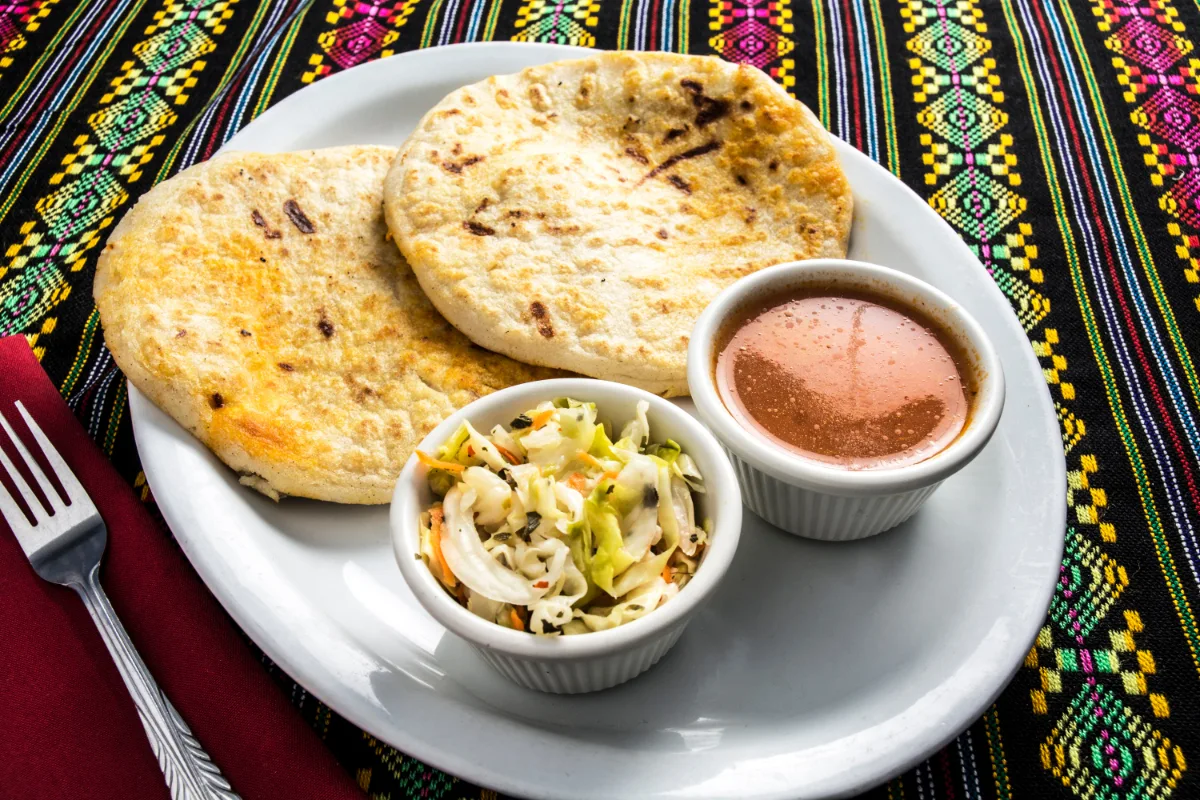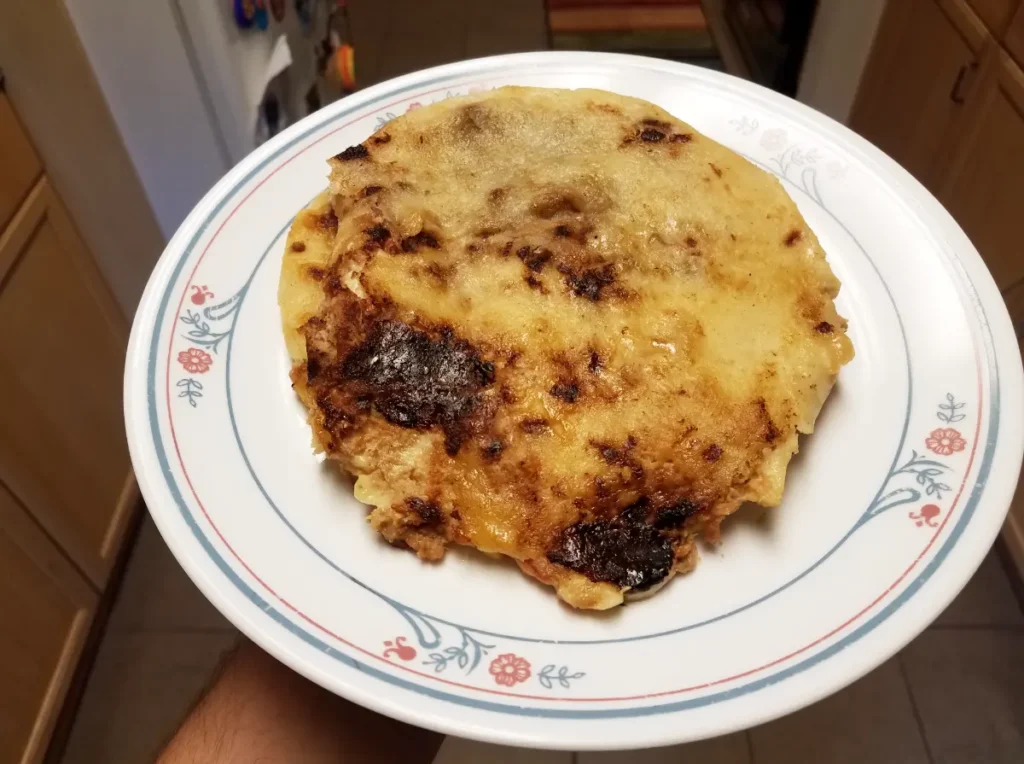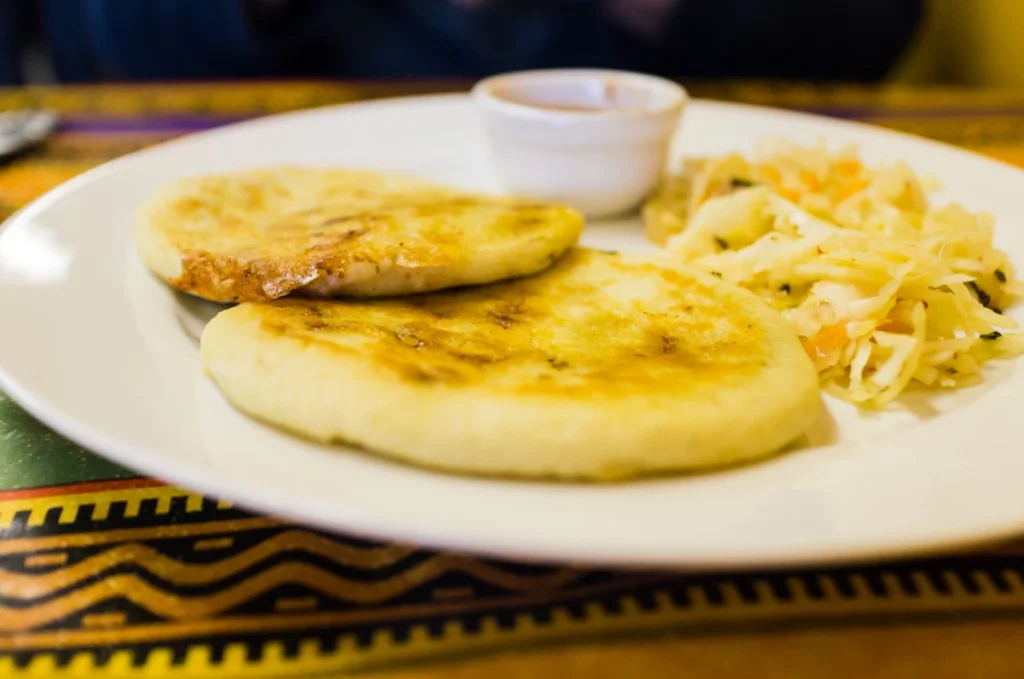Prepare for a tasty journey into the core of Salvadoran and Honduran cuisine with the cherished papusa. This thick griddle cake, akin to flatbread, is a staple in the culinary traditions of these Central American countries. In this article, we’ll reveal how to make perfect papusas at home, discuss their cultural importance, and explore the myriad of filling options and flavors. So, bring your appetite and join us in celebrating the delights of the papusa!
Introduction to Papusas
What is a Papusa?
The papusa is more than just a dish; it’s a symbol of cultural heritage and culinary artistry. Originating from El Salvador and Honduras, these thick, handmade delights are typically made from cornmeal or rice flour, giving them a slightly coarse yet pleasantly soft texture. Imagine a disc-shaped delight, about the size of your palm, with a golden-brown exterior that reveals a treasure trove of savory fillings within. While papusas share similarities with the Colombian and Venezuelan arepas, their unique ingredients and preparation methods set them apart as a distinct culinary experience.
Cultural Significance of Papusas
In El Salvador, the papusa reigns supreme as the national dish, a testament to its deep-rooted presence in the country’s culture and daily life. Traditionally, papusa-making was a communal activity, bringing families and communities together to share in the process of creating these culinary masterpieces. Whether enjoyed as a hearty breakfast, a satisfying lunch, or a comforting dinner, papusas are a staple on Salvadoran and Honduran tables, often accompanied by traditional sides like curtido (a fermented cabbage slaw) and salsa roja (a tomato-based sauce). The art of papusa-making has been passed down through generations, ensuring that this cherished tradition continues to thrive.
Making Papusas at Home
Ingredients for Papusas
Now, let’s gather the essential components for crafting your papusas. The foundation lies in the masa, a dough typically made from masa harina (corn flour) or rice flour. Add water and salt to create a pliable and slightly sticky dough, ready to embrace a variety of fillings. For those seeking a more adventurous flavor profile, consider incorporating ingredients like chipilín (a leafy green herb) or loroco (a vine flower bud native to Central America) into the masa for a touch of earthy and floral notes.
Papusa Fillings
The heart and soul of a papusa lie within its filling. The classic combination features queso (cheese) and frijoles (refried beans), a match made in culinary heaven. Melty cheeses like mozzarella or quesillo provide a gooey, satisfying contrast to the savory beans. For meat lovers, chicharrón (ground pork) adds a rich and flavorful dimension. And let’s not forget the unique taste of loroco, a true delicacy that infuses the papusa with a subtle, almost asparagus-like essence.
But the possibilities don’t end there! Vegetarian and vegan options abound, with fillings like sautéed vegetables, mushrooms, or even plant-based cheese substitutes. Feel free to unleash your creativity and experiment with your favorite ingredients, personalizing your papusas to suit your taste buds.
Step-by-Step Papusa Making Guide
- Making the Masa:
- In a bowl, combine the masa harina or rice flour with water and salt. Gradually add the water while kneading, ensuring a smooth and cohesive dough that doesn’t stick excessively to your hands. If the masa feels too dry, add a little more water; if it’s too wet, sprinkle in additional flour until you reach the desired consistency.
- Divide the masa into equal portions, forming balls about the size of a golf ball. Cover the balls with a damp cloth to prevent them from drying out as you prepare the fillings.
- Forming the Papusas:
-
- Take a masa ball and flatten it gently between your palms, creating a disc shape.
- Make a well in the center of the disc using your thumb. Fill the well with your chosen filling, ensuring not overstuff.
- Carefully fold the edges of the masa over the filling, sealing it completely to prevent any leakage during cooking. Gently flatten the papusa again, forming a uniform disc.
- Cooking the Papusas:
-
- Traditionally, papusas are cooked on a comal, a flat griddle, over medium heat. However, a skillet or frying pan can also be used. Lightly grease the cooking surface with oil to prevent sticking.
- Place the papusas on the hot surface and cook for about 3-4 minutes per side, or until golden brown spots appear and the filling is heated through. You can gently press down on the papusas with a spatula to ensure even cooking.
- Once cooked, transfer the papusas to a plate and keep them warm until ready to serve.
Serving and Enjoying Papusas
Traditional Accompaniments
No papusa experience is complete without its trusty companions: curtido and salsa roja. Curtido, a lightly fermented cabbage slaw with a tangy and refreshing flavor, provides the perfect counterpoint to the richness of the papusas. Its crunchy texture and vibrant taste add a delightful layer of complexity to each bite. Salsa roja, a tomato-based sauce, brings a touch of heat and spice, elevating the flavor profile even further.
For those seeking additional accompaniments, avocado slices, sour cream, or even a dash of hot sauce can complement the papusas beautifully. Feel free to explore and discover your favorite combinations!
Papusa Variations
While the classic papusa fillings remain popular, regional variations and innovative twists abound. In some areas, you might encounter papusas filled with ingredients like ayote (a type of squash), shrimp, or even cheese and loroco flowers. Modern interpretations may incorporate ingredients like spinach, jalapeños, or even black beans and sweet corn for a delightful fusion of flavors.
Where to Find Papusas
If you’re fortunate enough to visit El Salvador or Honduras, papusas will undoubtedly be a ubiquitous presence. From street vendors to family-run restaurants, the aroma of these freshly cooked delights will beckon you at every corner. Outside of Central America, Salvadoran restaurants and food trucks offer a taste of authenticity, bringing the papusa experience to a global audience. A quick online search or a browse through food blogs can help you locate the nearest papusa haven in your area. For those feeling adventurous, why not try your hand at making papusas at home? With a little practice and the right ingredients, you can recreate these culinary gems in your kitchen.
Health and Nutrition of Papusas
Nutritional Value of Papusas
Papusas offers a good balance of macronutrients, providing carbohydrates for energy, protein for muscle building and repair, and healthy fats. The specific nutritional content can vary depending on the type of flour used (corn or rice) and the fillings chosen.
- Carbohydrates: The primary source of carbohydrates in papusas is the masa, which is made from cornmeal or rice flour. These complex carbohydrates provide sustained energy and fiber, which aids in digestion.
- Protein: Papusas filled with cheese, beans, or chicharrón offer a good source of protein. Beans, in particular, are an excellent plant-based protein option, providing essential amino acids.
- Fats: The fat content in papusas can vary depending on the fillings. Cheese and chicharrón contribute to the fat content, while fillings like beans and vegetables offer a lower-fat option. Opting for leaner fillings and moderate portion sizes can help manage fat intake.
- Vitamins and Minerals: Papusas can provide essential vitamins and minerals, especially when filled with nutrient-rich ingredients like beans, cheese, or vegetables. Cornmeal is a good source of B vitamins and magnesium, while rice flour offers iron and some B vitamins.
Healthy Papusa Options
While papusas can be part of a balanced diet, it’s important to be mindful of portion sizes and fillings to keep things healthy. Here are some tips for enjoying papusas in a health-conscious way:
- Choose whole-grain masa: Opt for masa harina made from whole-grain corn for added fiber and nutrients.
- Go for lean fillings: Select fillings like beans, grilled chicken, or vegetables instead of high-fat options like chicharrón or excessive cheese.
- Load up on veggies: Add a side of curtido or a fresh salad to boost your intake of vitamins, minerals, and fiber.
- Be mindful of portion sizes: Enjoy papusas in moderation as part of a balanced meal.
- Consider baking or grilling: Explore healthier cooking methods like baking or grilling instead of frying.
By making informed choices and practicing moderation, you can savor the deliciousness of papusas while keeping your health goals in mind.
FAQs about Papusas
What is the Mexican version of a pupusa?
While Mexico has its rich tradition of corn-based dishes like tortillas and gorditas, there isn’t a direct equivalent to the Salvadoran and Honduran papusa. However, some Mexican dishes share similarities in terms of ingredients or preparation methods. For example, sopes are thick corn tortillas with pinched edges that can be topped with various ingredients, somewhat resembling the structure of a papusa. Additionally, gorditas are thick, pocket-like corn cakes that can be filled with savory or sweet ingredients, offering a similar concept to the papusa‘s filled nature.
What is the difference between arepa and papusa?
Both arepas and papusas are beloved staples in Latin American cuisine, but they have distinct characteristics that set them apart.
- Origin: Arepas hail from Colombia and Venezuela, while papusas originate from El Salvador and Honduras.
- Ingredients: Cooks typically use precooked cornmeal (masarepa) for arepas, while they make pupusas from masa harina (corn flour) or rice flour.
- Preparation: Cooks often grill or fry arepas after shaping them, while they cook pupusas on a comal (flat griddle) or in a skillet.
- Thickness: Arepas tend to be thinner and have a smoother texture, while pupusas are thicker with a slightly coarser texture.
- Fillings: Cooks often split open arepas and fill them after cooking, while they fill pupusas before cooking to integrate the flavors more fully.
What is the meaning of Papusa?
The exact origin of the word “papusa” is debated, but many believe it derives from the indigenous languages of El Salvador and Honduras.
Some theories suggest it may derive from the Pipil word “pupusawa,” which means “swollen,” referring to the papusa‘s plump shape. Others believe it may link to the word “papus,” meaning “mashed” or “mixed,” which reflects the process of preparing the masa.
What is the best way to reheat papusas?
To reheat papusas and retain their delicious texture, the comal or a skillet over medium heat is your best friend. Lightly oil the surface and warm the papusas for a few minutes on each side until heated through. Alternatively, you can use an oven preheated to 350°F (175°C) for about 10 minutes.
Can I make papusas gluten-free?
Absolutely! Rice flour is naturally gluten-free and makes an excellent substitute for masa harina in papusa dough. You can also explore other gluten-free flours like cassava flour or almond flour, adjusting the liquid content as needed to achieve the desired consistency.
How can I prevent papusas from falling apart?
The key to preventing papusa casualties lies in achieving the right masa consistency. The dough should be pliable and slightly sticky but not overly wet. Ensure you seal the fillings properly by completely enclosing them within the masa and gently flattening the papusas before cooking.
What are some good drinks to pair with papusas?
Traditional beverages like horchata (a sweet rice milk drink) or tamarindo (a tangy tamarind drink) complement the savory flavors of papusas beautifully. Fresh fruit juices, iced tea, or even a cold glass of milk can also be refreshing choices.
Are there any special occasions where papusas are traditionally eaten?
Papusas, a beloved staple in El Salvador and Honduras, delight people at everyday meals as well as festive celebrations. Whether it’s a casual family meal, a neighborhood gathering, or a national holiday, papusas always find a way to bring people together and create a sense of shared enjoyment.
Conclusion: Papusa A Culinary Treasure Worth Savoring
From their humble origins in El Salvador and Honduras, papusas have captured the hearts and taste buds of people around the world. Their simple yet versatile nature, combined with the rich cultural heritage they represent, makes them a true culinary treasure. Whether you’re a seasoned papusa enthusiast or a curious newcomer, we invite you to embark on your papusa adventure. Explore the endless possibilities of fillings, discover the joy of making them at home, or seek out authentic Salvadoran and Honduran cuisine in your local area.
With every bite, you’ll not only savor the deliciousness of this iconic dish but also connect with a vibrant culinary tradition passed down through generations. So, gather your loved ones, embrace the spirit of community, and enjoy the magic of pupusas!
More Delicious Recipes:
- Vermicelli: Savor the delightful textures and flavors of our vermicelli recipe, a versatile dish that can be enjoyed in countless variations. Whether you prefer it stir-fried with vegetables and proteins or served as a light, refreshing salad, this vermicelli recipe is sure to become a favorite.
Vermicelli: A Comprehensive Guide to Types, Uses, and Recipes
- Scrambled eggs in oven: Experience a new twist on a classic breakfast with our oven-baked scrambled eggs recipe. This easy and convenient method ensures perfectly cooked, fluffy eggs every time, with minimal effort. Ideal for busy mornings or serving a crowd, this recipe is a game-changer for egg lovers.




2 thoughts on “Papusa: A Culinary Adventure into Central American Cuisine”